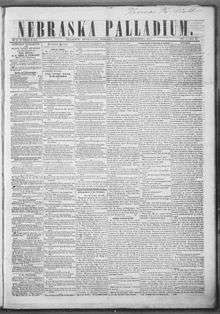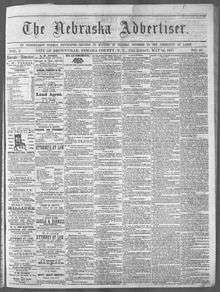Nebraska Territory
The Territory of Nebraska was an organized incorporated territory of the United States that existed from May 30, 1854, until March 1, 1867, when the final extent of the territory was admitted to the Union as the State of Nebraska. The Nebraska Territory was created by the Kansas–Nebraska Act of 1854. The territorial capital was Omaha. The territory encompassed areas of what is today Nebraska, Wyoming, South Dakota, North Dakota, Colorado, and Montana.
| Territory of Nebraska | |||||||||||||||||
|---|---|---|---|---|---|---|---|---|---|---|---|---|---|---|---|---|---|
| Organized incorporated territory of the United States | |||||||||||||||||
| 1854–1867 | |||||||||||||||||
| Capital | Omaha | ||||||||||||||||
| • Type | Organized incorporated territory | ||||||||||||||||
| History | |||||||||||||||||
| May 30, 1854 | |||||||||||||||||
• Colorado Territory formed | February 28, 1861 | ||||||||||||||||
• Dakota Territory formed | March 2, 1861 | ||||||||||||||||
• Idaho Territory formed | March 3, 1863 | ||||||||||||||||
| March 1, 1867 | |||||||||||||||||
| |||||||||||||||||
History
| Year | Pop. | ±% |
|---|---|---|
| 1860 | 28,841 | — |
| Source: 1860;[1] | ||
An enabling act was passed by Congress in 1864. Delegates for a constitutional convention were elected; this convention did not produce a constitution. Two years later, in 1866, a constitution was drafted and voted upon. It was approved by 100 votes. However, a clause in this constitution that limited suffrage to "free white males" delayed Nebraska's entry into the Union for almost a year. The 1866 enabling act for the state was subject to a pocket veto by President Andrew Johnson. When Congress reconvened in 1867, it passed another bill to create the state of Nebraska, on the condition that Nebraska's constitution be amended to remove the suffrage clause. This bill was also vetoed by President Johnson. Congress then overrode his veto.
Early settlement

Several trading posts, forts and towns were established in the Nebraska Territory from the early 19th century through 1867, including Fontenelle's Post founded in the present-day site of Bellevue in 1806. It was first mentioned in fur trading records in 1823. Fort Lisa, founded by Manuel Lisa near present-day Dodge Park in North Omaha was founded in 1812, although Lisa had earlier founded posts further up the Missouri River in Montana and North Dakota. Fort Atkinson, was founded on the Council Bluff in 1819; in 1822 Cabanne's Trading Post was founded nearby on the Missouri River. Mormon settlers founded Cutler's Park in 1846, and the town of Bellevue was incorporated in 1853. Nearby Omaha City was founded in 1854, with Nebraska City and Kearney incorporated in 1855. The influential towns of Brownville and Fontanelle were founded that year as well. The early village of Lancaster, later called Lincoln, was founded in 1856, along with the towns of Saratoga, South Nebraska City and Florence.[3]
Early press
The first newspaper published in the terrain that would become Nebraska was a weekly military journal stationed at Ft. Atkinson that was published for five years, from 1822 – 1827 before the fort was closed.[4] Thirty years later the Nebraska territory was settled and print media served the dual purposes of sharing the news and promoting the area for settlement. In 1854 the Nebraska Palladium[4] was the first paper to be published in the territory however it would last less than a year. These territorial newspapers were efficient but rough and many of the papers folded under quickly changed owners, or consolidated with other publications. By 1860 the Nebraska territory had twelve weekly publications, one biweekly and one monthly, with a combined circulation of 9,750. After statehood in 1867 the newspaper industry expanded greatly.[5]


| Pioneer Print Media in the Nebraska Territory[6] | |||||
|---|---|---|---|---|---|
| Name | Print period | Location | Notes | ||
| Nebraska Palladium and Platte Valley Advocate | July 15, 1854 –55 | Bellevue | Edited by Thomas Morton | ||
| Nebraskian | 1854–64 | Omaha | |||
| Bellevue gazette | October 23, 1856 – Oct. 1858 | Bellevue, Douglas, Nebraska | Published by S.A. Strickland & Co.[7] | ||
| Dakota City Herald | July 15, 1857 –1860 | Dakota City, Nebraska | Published by John L. Dailey | ||
| Nebraska Advertiser | June 7, 1856 – July 16, 1909 | Brownville | Edited by Robert W. Furnas[8] | ||
| Huntsman's Echo | 1858–1861 | Wood River, Buffalo County | Edited by Joseph E. Johnson, this paper was influential with Oregon Trail pioneers. | ||
| Nebraska Republican | 1858 | Omaha | The first paper in the Territory to have mechanical presses, this was later succeeded by the Omaha Republican, and in 1871 absorbed the Omaha Tribune. | ||
| Nebraska Farmer | 1859 | Brownville | Edited by Robert W. Furnas the Farmer was the first agricultural publication in Nebraska and continues to be one of the state's longest running journals | ||
| Peru Orchardist | Peru | ||||
| Daily Telegraph | 1860 | Omaha | |||
| Nebraska Deutsche Zeitung | 1861 | Nebraska City | Published by Frank Renner, this German language paper was circulated nationally and in Germany. It is credited with bringing many German settlers to the Territory. | ||
| Daily Herald | 1865 | Omaha | Edited by George L. Miller, this paper was influential in bringing the Union Pacific to Omaha. | ||
Early military posts
With a variety of early fur trading posts, Fort Atkinson, founded in 1819, was the location of the first military post in what became the Nebraska Territory, as well as its first school.[9] Other posts in the Nebraska Territory included Fort Kearny near present-day Kearney; Fort McPherson near present-day Maxwell; Fort Mitchell near present-day Scottsbluff; Fort Randall, in what is now South Dakota; and Fort Caspar, Fort Halleck, Fort Laramie, and Fort Sanders, in what is now Wyoming.
Boundaries
The Nebraska Territory's original boundaries (as specified by its Organic Act) included much of the original Louisiana Purchase; the territory's boundaries were:
- Southern: 40° N (the current Kansas–Nebraska border);
- Western: the Continental Divide between the Pacific and the Atlantic/Arctic Oceans;
- Northern: 49° N (the U.S.–British North America border);
- Eastern: the White Earth and Missouri rivers.
Subsequent territory creation
Upon creation, the territory encompassed most of the northern Great Plains, much of the upper Missouri River basin and the eastern portions of the northern Rocky Mountains. The Nebraska Territory gradually reduced in size as new territories were created in the 1860s.
The Colorado Territory was formed February 28, 1861 from portions of the territory south of 41° N and west of 102°03′ W (25° W of Washington, D.C.) (an area that includes present-day Fort Collins, Greeley and the portions of Boulder north of Baseline Road, in addition to portions of Kansas Territory, New Mexico Territory, and Utah Territory).
March 2, 1861, saw the creation of the Dakota Territory. It was made of all of the portions of Nebraska Territory north of 43° N (the present-day Nebraska–South Dakota border), along with the portion of present-day Nebraska between 43° N and the Keya Paha and Niobrara rivers (this land would be returned to Nebraska in 1882). The act creating the Dakota Territory also included provisions granting Nebraska small portions of Utah Territory and Washington Territory—present-day southwestern Wyoming bounded by 41° N, 110°03′ W (33° W of Washington, D.C.), 43° N, and the Continental Divide. These portions had not been part of the Louisiana Purchase; rather, they had been part of Oregon Country and became part of the United States in 1846.
On March 3, 1863, the Idaho Territory was formed of all the territory west of 104°03′ W (27° W of Washington, D.C.).
See also
References
- Forstall, Richard L. (ed.). Population of the States and Counties of the United States: 1790–1990 (PDF) (Report). United States Census Bureau. p. 3. Retrieved May 18, 2020.
- City of Omaha, Nebraska. "Bank Note, City of Omaha, $1; Scrip, 1857". Lincoln, NE: Nebraska State Historical Society. Retrieved October 4, 2015.
- Federal Writers Project. (1939) Nebraska. Lincoln, NE: Nebraska State Historical Society. p 49.
- Walter, Katherine. "Nebraska Publishing". Nebraska Newspapers. University of Nebraska-Lincoln.
- Federal Writers Project. (1939) Nebraska. Lincoln, NE: Nebraska State Historical Society. p 134.
- Federal Writers Project. (1939) Nebraska. Lincoln, NE: Nebraska State Historical Society. p 133.
- Walter, Katherine. "About Bellevue gazette". Nebraska Newspapers. University of Nebraska-Lincoln.
- Walter, Katherine. "About Nebraska Advertiser". Nebraska Newspaper. University of Nebraska-Lincoln.
- (n.d.) World Almanac for Kids: Nebraska: Education.